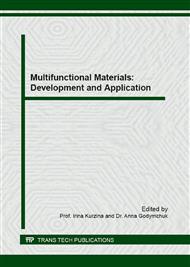[1]
World Health Statistics 2014: Indicator compendium, World Health Organization, Geneva, (2015).
Google Scholar
[2]
T.M. Kolettis, Coronary artery disease and ventricular tachyarrhythmia: pathophysiology and treatment, Curr. Opin. Pharmacol. 13 (2013) 1-8.
Google Scholar
[3]
M.E.M. Garzon, M.B. Miller, S. Borzak, L. Tamariz, Early repolarization and risk for ventricular arrhythmias in patients with coronary artery disease: a meta-analysis, J. Amer. College of Cardiology. 63 (2014) DOI: 10. 1016/S0735-1097(14)60335-1.
DOI: 10.1016/s0735-1097(14)60335-1
Google Scholar
[4]
J. Lønborg, N. Vejlstrup, H. Kelbæk, H.E. Bøtker, W.Y. Kim, A.B. Mathiasen, T. Engstrøm, Exenatide reduces reperfusion injury in patients with ST-segment elevation myocardial infarction, Eur. Heart J. 12 (2012) 1491-1499.
DOI: 10.1093/eurheartj/ehr309
Google Scholar
[5]
E. Kleina, V. Lukesb, Z. Cibulkova, On the energetics of phenol antioxidants activity, Petroleum and Coal. 1 (2005) 33-39.
Google Scholar
[6]
S. Fujisawa, Y. Kadoma, I. Yokoe, Radical-scavenging activity of butylated hydroxytoluene (BHT) and its metabolites, Chem. Phys. Lipids. 2 (2004) 189-195.
DOI: 10.1016/j.chemphyslip.2004.03.005
Google Scholar
[7]
T.M. Plotnikova, G.A. Chernysheva, V.I. Smol'yakova, P.P. Shchetinin, A.V. Kuchin, I.Y. Chukicheva, M.B. Plotnikov, Hemorheologic Effects of dibornol in a model of myocardial ischemia/reperfusion, Bull. Exp. Biol. Med. 157(2) (2014) 211-214.
DOI: 10.1007/s10517-014-2527-8
Google Scholar
[8]
A.N. Mironov, A.N. Bunatyan, Guide to experimental (preclinical) study of new pharmacological substances, Moscow [in Russian], (2013).
Google Scholar
[9]
X. He, M. Zhao, X.Y. Bi, Delayed preconditioning prevents ischemia/reperfusion-induced endothelial injury in rats: role of ROS and eNOS, Lab. Invest. 93 (2013) 168-180.
DOI: 10.1038/labinvest.2012.160
Google Scholar
[10]
W. Davis Prophylactic Antioxidant use for the Prevention of Post-Operative Atrial Fibrillation in Cardiac Surgery Patients, Pacific University Common Knowledge, 2014, Available at: http: /commons. pacificu. edu/cgi/viewcontent. cgi?article=1504&context=pa.
Google Scholar
[11]
N. Fillmore, J. Mori, G.D. Lopaschuk Mitochondrial fatty acid oxidation alterations in heart failure, ischemic heart disease and diabetic cardiomyophaty, Br J Pharmacol. 8 (2014) 2080-(2090).
DOI: 10.1111/bph.12475
Google Scholar


